Impact of Work Design on Employee Innovation: A Human Resource Report
VerifiedAdded on 2019/09/20
|15
|3299
|330
Report
AI Summary
This report delves into the critical role of work design in fostering employee innovation within organizations. It explores how work design, as a core function of human resource management, influences employee motivation, job satisfaction, and overall well-being. The report examines the importance of work design in providing benefits to various stakeholders, including employees, businesses, and customers. It discusses the Job Characteristics Theory, detailing the five main characteristics of a job and their impact on psychological states. Furthermore, the report outlines various techniques of job design, such as job rotation and job enrichment, and analyzes factors that support innovative behavior, including psychological capital, organizational commitment, social capital, and motivational work design. The report also touches upon the influence of human resource practices on innovation and concludes with the importance of creating an innovative organizational environment. This report provides valuable insights into the strategic importance of work design in driving employee innovation and achieving organizational goals.
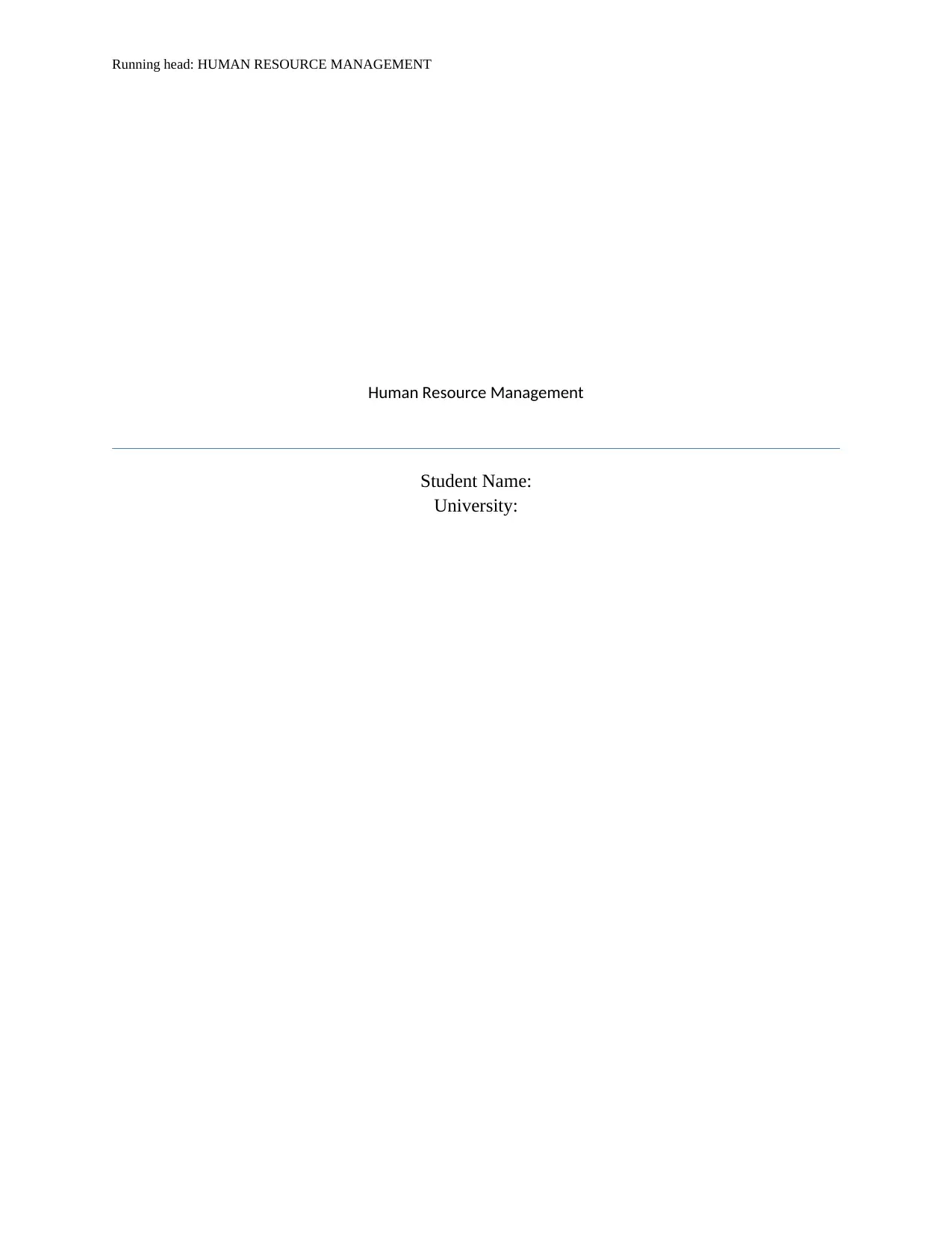
Running head: HUMAN RESOURCE MANAGEMENT
Human Resource Management
Student Name:
University:
Human Resource Management
Student Name:
University:
Paraphrase This Document
Need a fresh take? Get an instant paraphrase of this document with our AI Paraphraser
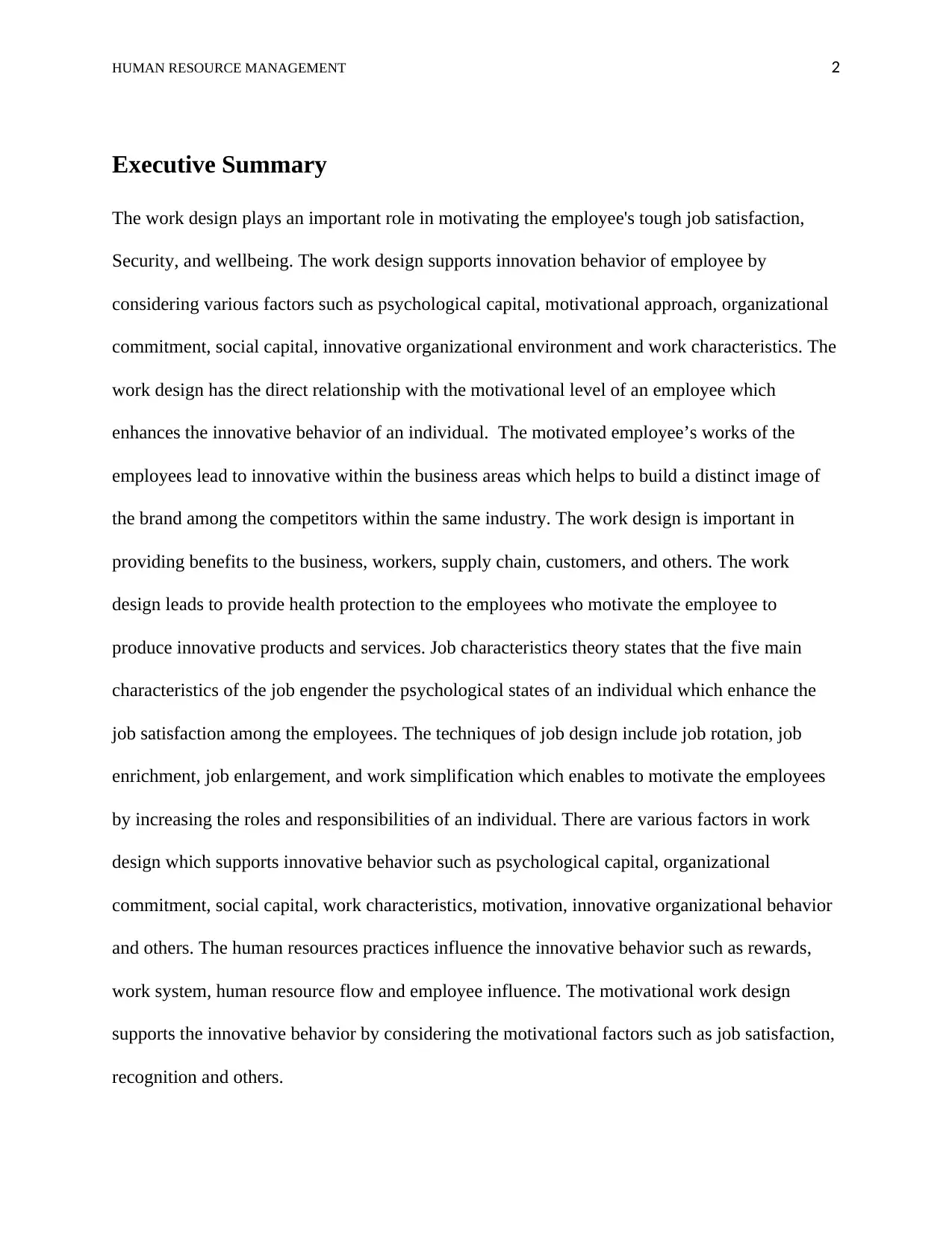
HUMAN RESOURCE MANAGEMENT 2
Executive Summary
The work design plays an important role in motivating the employee's tough job satisfaction,
Security, and wellbeing. The work design supports innovation behavior of employee by
considering various factors such as psychological capital, motivational approach, organizational
commitment, social capital, innovative organizational environment and work characteristics. The
work design has the direct relationship with the motivational level of an employee which
enhances the innovative behavior of an individual. The motivated employee’s works of the
employees lead to innovative within the business areas which helps to build a distinct image of
the brand among the competitors within the same industry. The work design is important in
providing benefits to the business, workers, supply chain, customers, and others. The work
design leads to provide health protection to the employees who motivate the employee to
produce innovative products and services. Job characteristics theory states that the five main
characteristics of the job engender the psychological states of an individual which enhance the
job satisfaction among the employees. The techniques of job design include job rotation, job
enrichment, job enlargement, and work simplification which enables to motivate the employees
by increasing the roles and responsibilities of an individual. There are various factors in work
design which supports innovative behavior such as psychological capital, organizational
commitment, social capital, work characteristics, motivation, innovative organizational behavior
and others. The human resources practices influence the innovative behavior such as rewards,
work system, human resource flow and employee influence. The motivational work design
supports the innovative behavior by considering the motivational factors such as job satisfaction,
recognition and others.
Executive Summary
The work design plays an important role in motivating the employee's tough job satisfaction,
Security, and wellbeing. The work design supports innovation behavior of employee by
considering various factors such as psychological capital, motivational approach, organizational
commitment, social capital, innovative organizational environment and work characteristics. The
work design has the direct relationship with the motivational level of an employee which
enhances the innovative behavior of an individual. The motivated employee’s works of the
employees lead to innovative within the business areas which helps to build a distinct image of
the brand among the competitors within the same industry. The work design is important in
providing benefits to the business, workers, supply chain, customers, and others. The work
design leads to provide health protection to the employees who motivate the employee to
produce innovative products and services. Job characteristics theory states that the five main
characteristics of the job engender the psychological states of an individual which enhance the
job satisfaction among the employees. The techniques of job design include job rotation, job
enrichment, job enlargement, and work simplification which enables to motivate the employees
by increasing the roles and responsibilities of an individual. There are various factors in work
design which supports innovative behavior such as psychological capital, organizational
commitment, social capital, work characteristics, motivation, innovative organizational behavior
and others. The human resources practices influence the innovative behavior such as rewards,
work system, human resource flow and employee influence. The motivational work design
supports the innovative behavior by considering the motivational factors such as job satisfaction,
recognition and others.
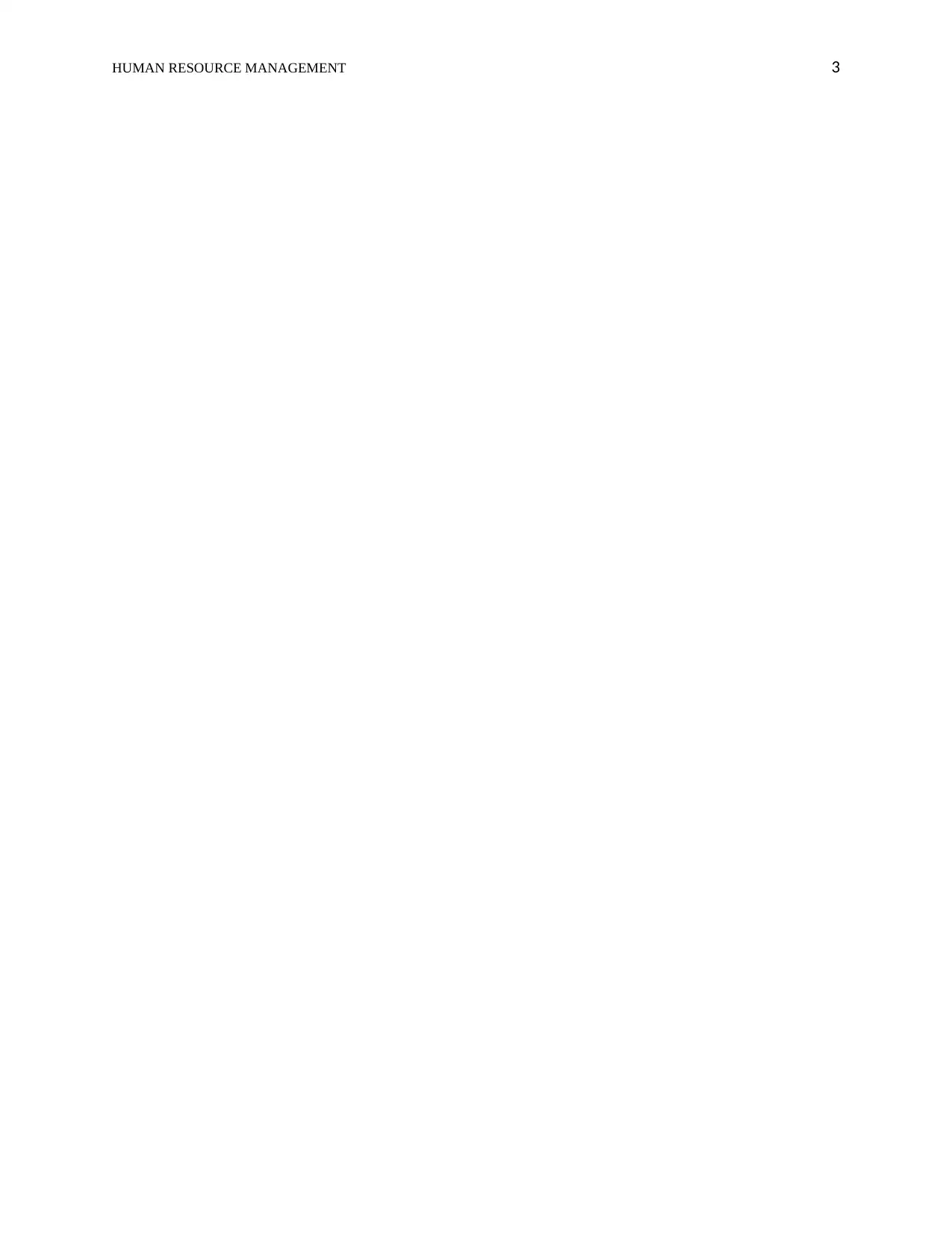
HUMAN RESOURCE MANAGEMENT 3
⊘ This is a preview!⊘
Do you want full access?
Subscribe today to unlock all pages.

Trusted by 1+ million students worldwide
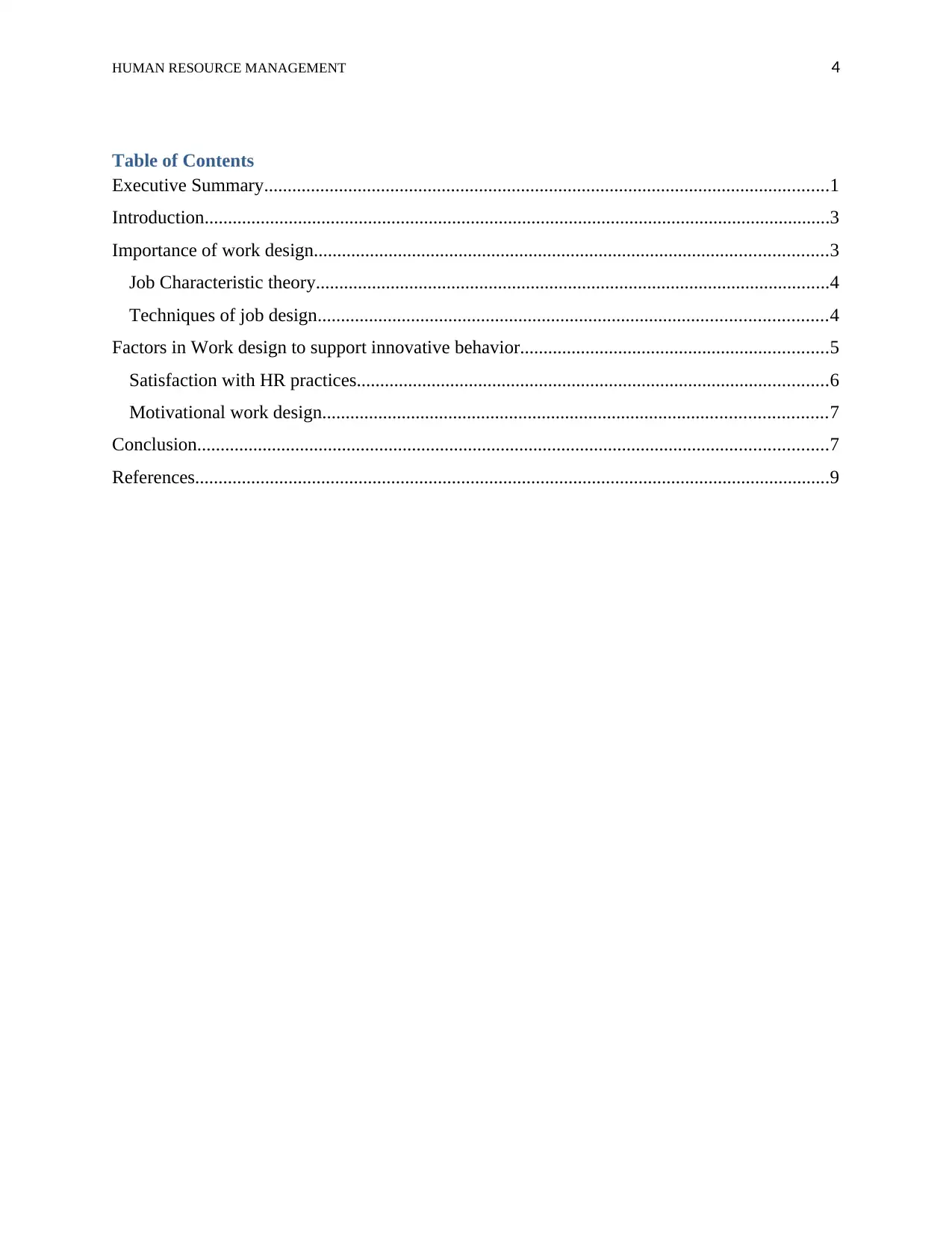
HUMAN RESOURCE MANAGEMENT 4
Table of Contents
Executive Summary.........................................................................................................................1
Introduction......................................................................................................................................3
Importance of work design..............................................................................................................3
Job Characteristic theory..............................................................................................................4
Techniques of job design.............................................................................................................4
Factors in Work design to support innovative behavior..................................................................5
Satisfaction with HR practices.....................................................................................................6
Motivational work design............................................................................................................7
Conclusion.......................................................................................................................................7
References........................................................................................................................................9
Table of Contents
Executive Summary.........................................................................................................................1
Introduction......................................................................................................................................3
Importance of work design..............................................................................................................3
Job Characteristic theory..............................................................................................................4
Techniques of job design.............................................................................................................4
Factors in Work design to support innovative behavior..................................................................5
Satisfaction with HR practices.....................................................................................................6
Motivational work design............................................................................................................7
Conclusion.......................................................................................................................................7
References........................................................................................................................................9
Paraphrase This Document
Need a fresh take? Get an instant paraphrase of this document with our AI Paraphraser
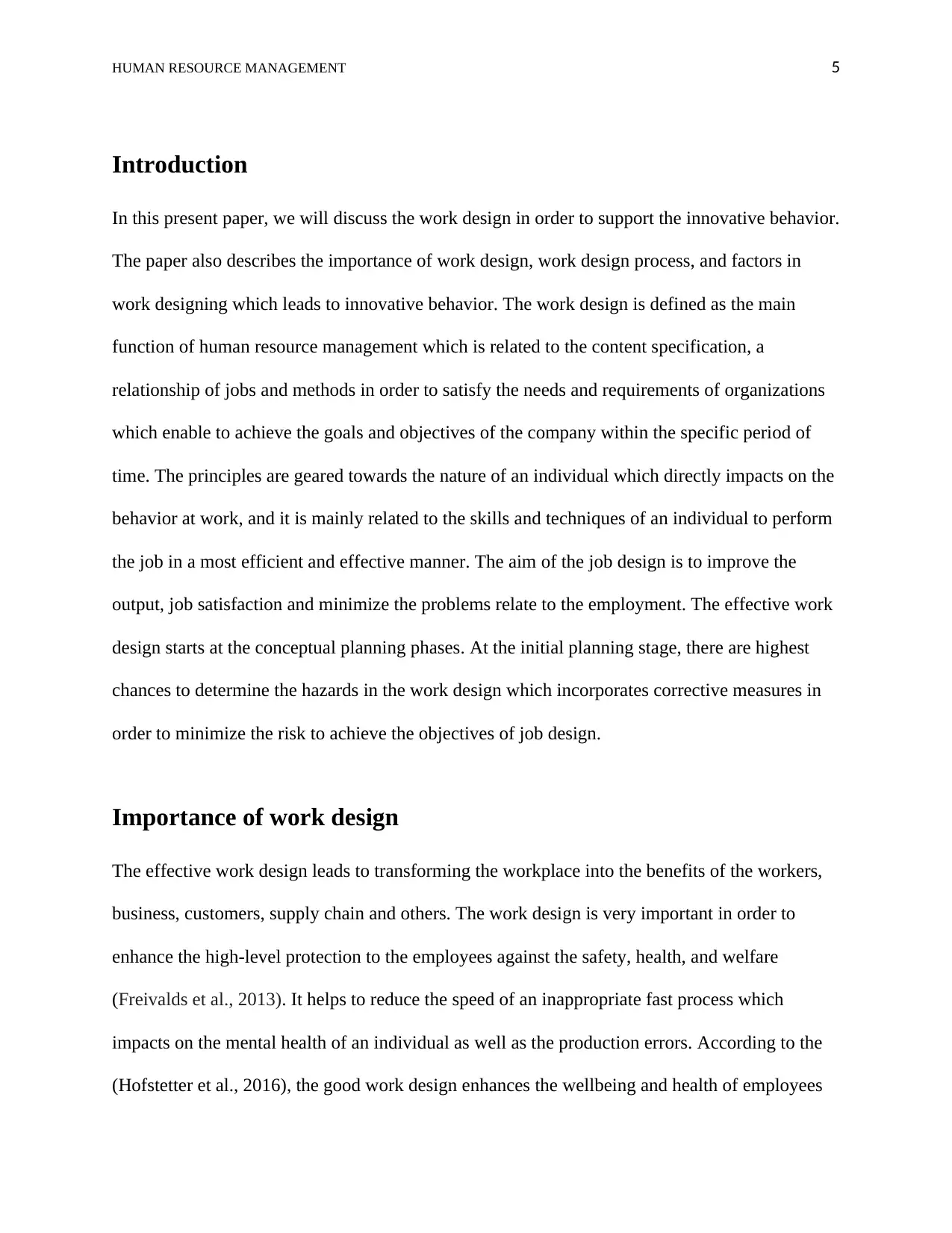
HUMAN RESOURCE MANAGEMENT 5
Introduction
In this present paper, we will discuss the work design in order to support the innovative behavior.
The paper also describes the importance of work design, work design process, and factors in
work designing which leads to innovative behavior. The work design is defined as the main
function of human resource management which is related to the content specification, a
relationship of jobs and methods in order to satisfy the needs and requirements of organizations
which enable to achieve the goals and objectives of the company within the specific period of
time. The principles are geared towards the nature of an individual which directly impacts on the
behavior at work, and it is mainly related to the skills and techniques of an individual to perform
the job in a most efficient and effective manner. The aim of the job design is to improve the
output, job satisfaction and minimize the problems relate to the employment. The effective work
design starts at the conceptual planning phases. At the initial planning stage, there are highest
chances to determine the hazards in the work design which incorporates corrective measures in
order to minimize the risk to achieve the objectives of job design.
Importance of work design
The effective work design leads to transforming the workplace into the benefits of the workers,
business, customers, supply chain and others. The work design is very important in order to
enhance the high-level protection to the employees against the safety, health, and welfare
(Freivalds et al., 2013). It helps to reduce the speed of an inappropriate fast process which
impacts on the mental health of an individual as well as the production errors. According to the
(Hofstetter et al., 2016), the good work design enhances the wellbeing and health of employees
Introduction
In this present paper, we will discuss the work design in order to support the innovative behavior.
The paper also describes the importance of work design, work design process, and factors in
work designing which leads to innovative behavior. The work design is defined as the main
function of human resource management which is related to the content specification, a
relationship of jobs and methods in order to satisfy the needs and requirements of organizations
which enable to achieve the goals and objectives of the company within the specific period of
time. The principles are geared towards the nature of an individual which directly impacts on the
behavior at work, and it is mainly related to the skills and techniques of an individual to perform
the job in a most efficient and effective manner. The aim of the job design is to improve the
output, job satisfaction and minimize the problems relate to the employment. The effective work
design starts at the conceptual planning phases. At the initial planning stage, there are highest
chances to determine the hazards in the work design which incorporates corrective measures in
order to minimize the risk to achieve the objectives of job design.
Importance of work design
The effective work design leads to transforming the workplace into the benefits of the workers,
business, customers, supply chain and others. The work design is very important in order to
enhance the high-level protection to the employees against the safety, health, and welfare
(Freivalds et al., 2013). It helps to reduce the speed of an inappropriate fast process which
impacts on the mental health of an individual as well as the production errors. According to the
(Hofstetter et al., 2016), the good work design enhances the wellbeing and health of employees

HUMAN RESOURCE MANAGEMENT 6
by improving the participation inability of workers which leads to the productive work lives.
(Landy et al., 2016) States that the good work designs enhance the success of business and
productivity by providing the health protection to the employees. The work design helps to
reduce the cost by eliminating the disruptions to the work processes which generates the costs of
employee injury at a workplace. The work design is very necessary in order to sustain the
business by adjusting the needs of business and streamline the work processes through
minimizing the wastage and cost of supervision. (Tan et al., 2014) mentioned that the work
design plays a critical role in improving the opportunities for innovation and creativity in order
to resolve the issues of production by minimizing the errors in the quality of products and
services. (Kendall et al., 2014) state that it helps to utilize the skills of workers in an effective
manner through engaging and motivating the employees to contribute towards the achievement
of organizational goals and objectives. The good work design addresses the biochemical,
physical, cognitive and psychosocial characteristics of work with the requirements and
capabilities of an individual. The work design should consider the characteristics of work in a
systematic manner in order to assess the risk. The job satisfaction and autonomy support the
innovative behavior of an individual which provides a competitive advantage to the company
and it helps to stand out among the competitors within the same industry.
Job Characteristic theory
The job characteristics theory was introduced by Hackman & Oldman in 1976 which states that
the work should be design in order to five main characteristics of jobs which engender three
main psychological states in an individual, namely, responsibility towards the output,
understanding the outcomes of current efforts and meaning of experiencing (Bakker et al., 2014).
The psychological states lead to enhance the job satisfaction improves the quality of work,
by improving the participation inability of workers which leads to the productive work lives.
(Landy et al., 2016) States that the good work designs enhance the success of business and
productivity by providing the health protection to the employees. The work design helps to
reduce the cost by eliminating the disruptions to the work processes which generates the costs of
employee injury at a workplace. The work design is very necessary in order to sustain the
business by adjusting the needs of business and streamline the work processes through
minimizing the wastage and cost of supervision. (Tan et al., 2014) mentioned that the work
design plays a critical role in improving the opportunities for innovation and creativity in order
to resolve the issues of production by minimizing the errors in the quality of products and
services. (Kendall et al., 2014) state that it helps to utilize the skills of workers in an effective
manner through engaging and motivating the employees to contribute towards the achievement
of organizational goals and objectives. The good work design addresses the biochemical,
physical, cognitive and psychosocial characteristics of work with the requirements and
capabilities of an individual. The work design should consider the characteristics of work in a
systematic manner in order to assess the risk. The job satisfaction and autonomy support the
innovative behavior of an individual which provides a competitive advantage to the company
and it helps to stand out among the competitors within the same industry.
Job Characteristic theory
The job characteristics theory was introduced by Hackman & Oldman in 1976 which states that
the work should be design in order to five main characteristics of jobs which engender three
main psychological states in an individual, namely, responsibility towards the output,
understanding the outcomes of current efforts and meaning of experiencing (Bakker et al., 2014).
The psychological states lead to enhance the job satisfaction improves the quality of work,
⊘ This is a preview!⊘
Do you want full access?
Subscribe today to unlock all pages.

Trusted by 1+ million students worldwide
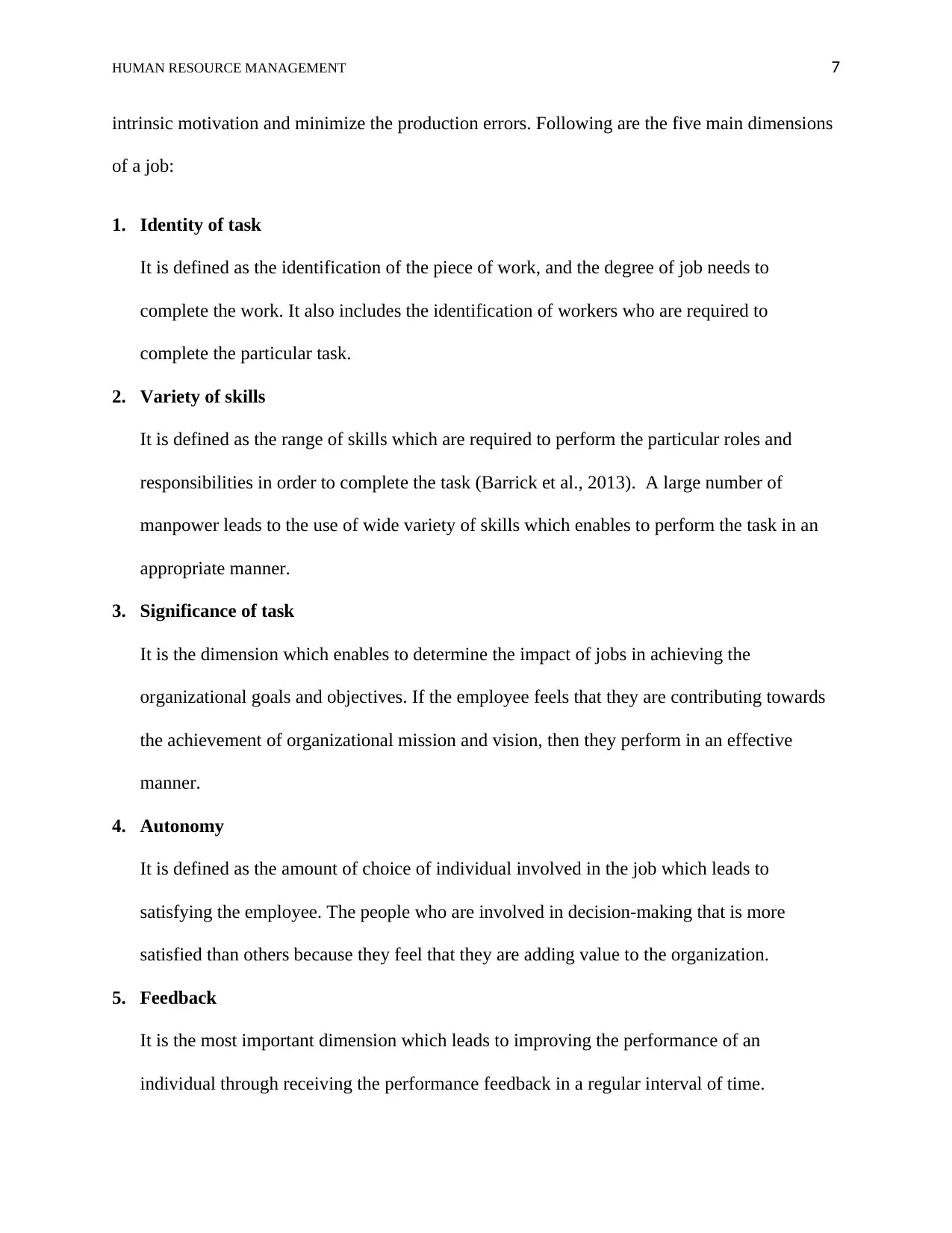
HUMAN RESOURCE MANAGEMENT 7
intrinsic motivation and minimize the production errors. Following are the five main dimensions
of a job:
1. Identity of task
It is defined as the identification of the piece of work, and the degree of job needs to
complete the work. It also includes the identification of workers who are required to
complete the particular task.
2. Variety of skills
It is defined as the range of skills which are required to perform the particular roles and
responsibilities in order to complete the task (Barrick et al., 2013). A large number of
manpower leads to the use of wide variety of skills which enables to perform the task in an
appropriate manner.
3. Significance of task
It is the dimension which enables to determine the impact of jobs in achieving the
organizational goals and objectives. If the employee feels that they are contributing towards
the achievement of organizational mission and vision, then they perform in an effective
manner.
4. Autonomy
It is defined as the amount of choice of individual involved in the job which leads to
satisfying the employee. The people who are involved in decision-making that is more
satisfied than others because they feel that they are adding value to the organization.
5. Feedback
It is the most important dimension which leads to improving the performance of an
individual through receiving the performance feedback in a regular interval of time.
intrinsic motivation and minimize the production errors. Following are the five main dimensions
of a job:
1. Identity of task
It is defined as the identification of the piece of work, and the degree of job needs to
complete the work. It also includes the identification of workers who are required to
complete the particular task.
2. Variety of skills
It is defined as the range of skills which are required to perform the particular roles and
responsibilities in order to complete the task (Barrick et al., 2013). A large number of
manpower leads to the use of wide variety of skills which enables to perform the task in an
appropriate manner.
3. Significance of task
It is the dimension which enables to determine the impact of jobs in achieving the
organizational goals and objectives. If the employee feels that they are contributing towards
the achievement of organizational mission and vision, then they perform in an effective
manner.
4. Autonomy
It is defined as the amount of choice of individual involved in the job which leads to
satisfying the employee. The people who are involved in decision-making that is more
satisfied than others because they feel that they are adding value to the organization.
5. Feedback
It is the most important dimension which leads to improving the performance of an
individual through receiving the performance feedback in a regular interval of time.
Paraphrase This Document
Need a fresh take? Get an instant paraphrase of this document with our AI Paraphraser
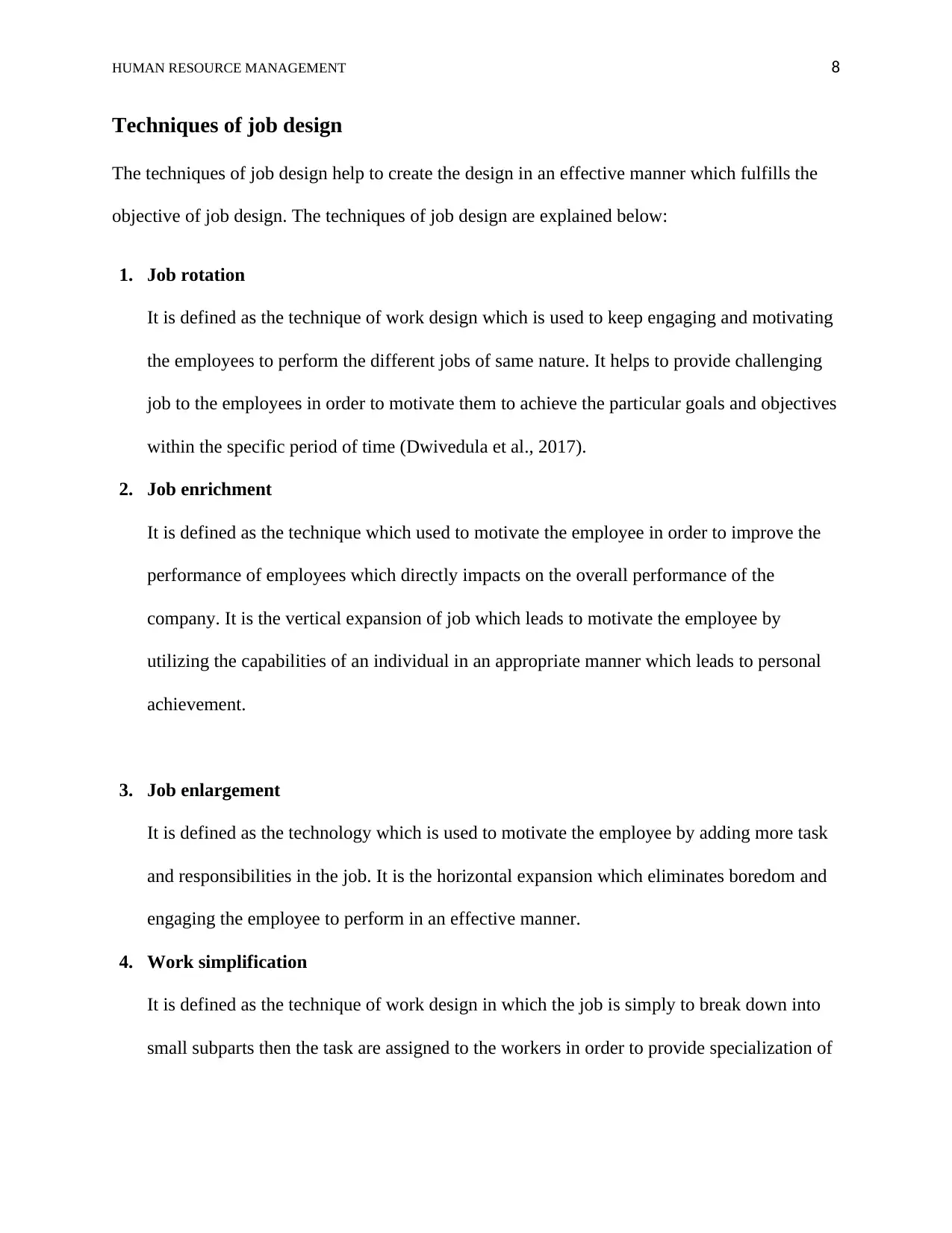
HUMAN RESOURCE MANAGEMENT 8
Techniques of job design
The techniques of job design help to create the design in an effective manner which fulfills the
objective of job design. The techniques of job design are explained below:
1. Job rotation
It is defined as the technique of work design which is used to keep engaging and motivating
the employees to perform the different jobs of same nature. It helps to provide challenging
job to the employees in order to motivate them to achieve the particular goals and objectives
within the specific period of time (Dwivedula et al., 2017).
2. Job enrichment
It is defined as the technique which used to motivate the employee in order to improve the
performance of employees which directly impacts on the overall performance of the
company. It is the vertical expansion of job which leads to motivate the employee by
utilizing the capabilities of an individual in an appropriate manner which leads to personal
achievement.
3. Job enlargement
It is defined as the technology which is used to motivate the employee by adding more task
and responsibilities in the job. It is the horizontal expansion which eliminates boredom and
engaging the employee to perform in an effective manner.
4. Work simplification
It is defined as the technique of work design in which the job is simply to break down into
small subparts then the task are assigned to the workers in order to provide specialization of
Techniques of job design
The techniques of job design help to create the design in an effective manner which fulfills the
objective of job design. The techniques of job design are explained below:
1. Job rotation
It is defined as the technique of work design which is used to keep engaging and motivating
the employees to perform the different jobs of same nature. It helps to provide challenging
job to the employees in order to motivate them to achieve the particular goals and objectives
within the specific period of time (Dwivedula et al., 2017).
2. Job enrichment
It is defined as the technique which used to motivate the employee in order to improve the
performance of employees which directly impacts on the overall performance of the
company. It is the vertical expansion of job which leads to motivate the employee by
utilizing the capabilities of an individual in an appropriate manner which leads to personal
achievement.
3. Job enlargement
It is defined as the technology which is used to motivate the employee by adding more task
and responsibilities in the job. It is the horizontal expansion which eliminates boredom and
engaging the employee to perform in an effective manner.
4. Work simplification
It is defined as the technique of work design in which the job is simply to break down into
small subparts then the task are assigned to the workers in order to provide specialization of

HUMAN RESOURCE MANAGEMENT 9
work to the workers which improve the quality of productivity and skills of an individual to
perform the job in an effective manner (Freeney et al., 2013).
Factors in Work design to support innovative behavior
The innovative behavior of employees refers to the introduction, creation and application of new
ideas in an organization in order to provide a competitive advantage to the company through
distinct the brand's image in the eyes of the customers. Following are the various factors which
support the innovative behavior of employees in the organization:
1. Psychological capital
According to the researchers, the psychological characteristics of an individual lead to the
innovative behavior. Sweetman et al., 2010 found that there is the positive relationship
between all the variables and innovative behavior of employees. It is the most important
factor which needs to be considered at the time of work designing which supports the
innovative behavior of employees.
2. Organizational commitment
The organizational commitment must be considered in the work design in order to obtain to
obtain the working outcome from the employees. The commitment is divided into negative
emotional commitment and positive emotional commitment. King et al., 2002 states that the
employees who highly agree with the organizational commitments that lead to the innovative
behavior of employees. Tao Youmei et al., 2012 states that the employee positive
commitment is an important prerequisite in order to promote innovative behavior of
employees.
3. Social capital
work to the workers which improve the quality of productivity and skills of an individual to
perform the job in an effective manner (Freeney et al., 2013).
Factors in Work design to support innovative behavior
The innovative behavior of employees refers to the introduction, creation and application of new
ideas in an organization in order to provide a competitive advantage to the company through
distinct the brand's image in the eyes of the customers. Following are the various factors which
support the innovative behavior of employees in the organization:
1. Psychological capital
According to the researchers, the psychological characteristics of an individual lead to the
innovative behavior. Sweetman et al., 2010 found that there is the positive relationship
between all the variables and innovative behavior of employees. It is the most important
factor which needs to be considered at the time of work designing which supports the
innovative behavior of employees.
2. Organizational commitment
The organizational commitment must be considered in the work design in order to obtain to
obtain the working outcome from the employees. The commitment is divided into negative
emotional commitment and positive emotional commitment. King et al., 2002 states that the
employees who highly agree with the organizational commitments that lead to the innovative
behavior of employees. Tao Youmei et al., 2012 states that the employee positive
commitment is an important prerequisite in order to promote innovative behavior of
employees.
3. Social capital
⊘ This is a preview!⊘
Do you want full access?
Subscribe today to unlock all pages.

Trusted by 1+ million students worldwide
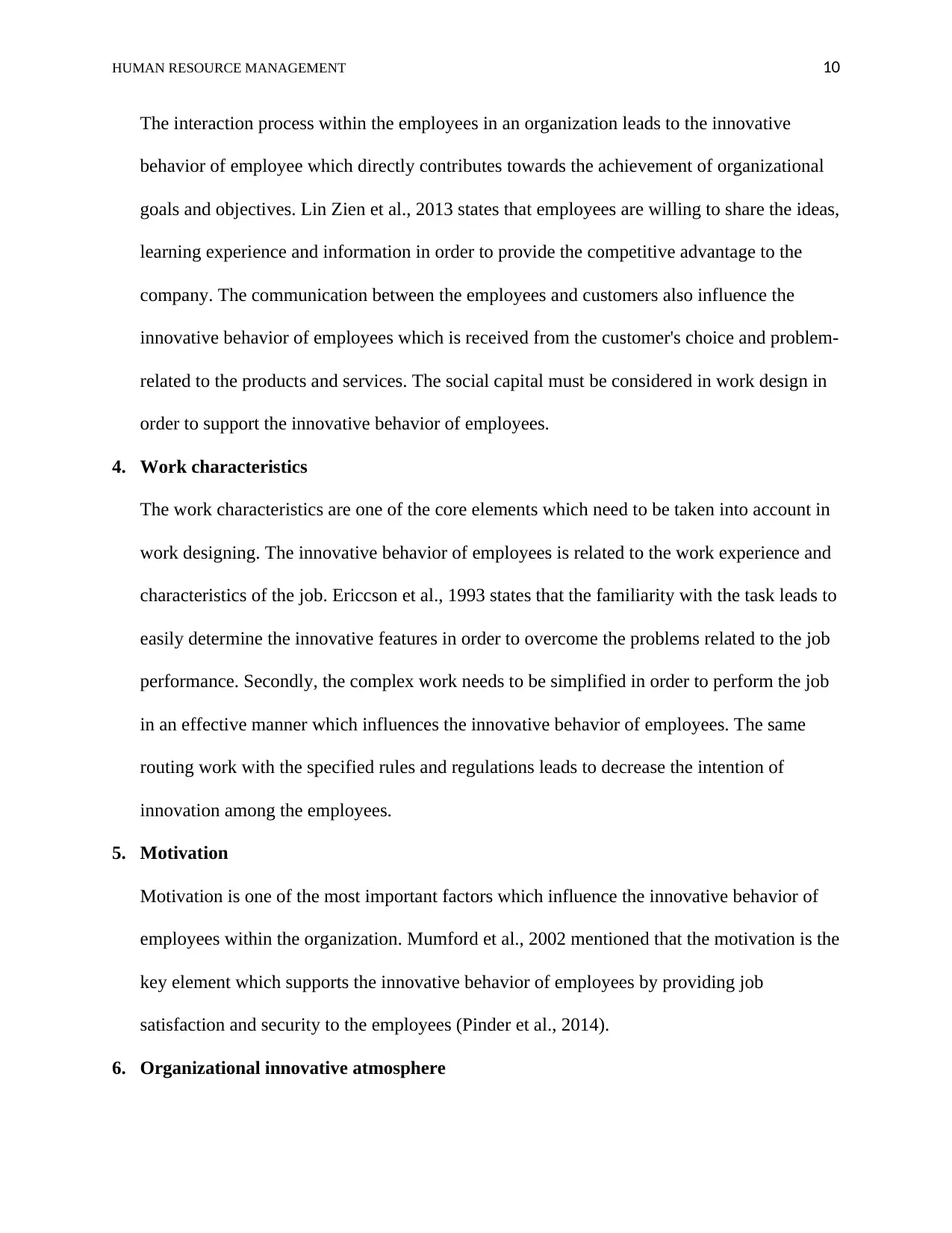
HUMAN RESOURCE MANAGEMENT 10
The interaction process within the employees in an organization leads to the innovative
behavior of employee which directly contributes towards the achievement of organizational
goals and objectives. Lin Zien et al., 2013 states that employees are willing to share the ideas,
learning experience and information in order to provide the competitive advantage to the
company. The communication between the employees and customers also influence the
innovative behavior of employees which is received from the customer's choice and problem-
related to the products and services. The social capital must be considered in work design in
order to support the innovative behavior of employees.
4. Work characteristics
The work characteristics are one of the core elements which need to be taken into account in
work designing. The innovative behavior of employees is related to the work experience and
characteristics of the job. Ericcson et al., 1993 states that the familiarity with the task leads to
easily determine the innovative features in order to overcome the problems related to the job
performance. Secondly, the complex work needs to be simplified in order to perform the job
in an effective manner which influences the innovative behavior of employees. The same
routing work with the specified rules and regulations leads to decrease the intention of
innovation among the employees.
5. Motivation
Motivation is one of the most important factors which influence the innovative behavior of
employees within the organization. Mumford et al., 2002 mentioned that the motivation is the
key element which supports the innovative behavior of employees by providing job
satisfaction and security to the employees (Pinder et al., 2014).
6. Organizational innovative atmosphere
The interaction process within the employees in an organization leads to the innovative
behavior of employee which directly contributes towards the achievement of organizational
goals and objectives. Lin Zien et al., 2013 states that employees are willing to share the ideas,
learning experience and information in order to provide the competitive advantage to the
company. The communication between the employees and customers also influence the
innovative behavior of employees which is received from the customer's choice and problem-
related to the products and services. The social capital must be considered in work design in
order to support the innovative behavior of employees.
4. Work characteristics
The work characteristics are one of the core elements which need to be taken into account in
work designing. The innovative behavior of employees is related to the work experience and
characteristics of the job. Ericcson et al., 1993 states that the familiarity with the task leads to
easily determine the innovative features in order to overcome the problems related to the job
performance. Secondly, the complex work needs to be simplified in order to perform the job
in an effective manner which influences the innovative behavior of employees. The same
routing work with the specified rules and regulations leads to decrease the intention of
innovation among the employees.
5. Motivation
Motivation is one of the most important factors which influence the innovative behavior of
employees within the organization. Mumford et al., 2002 mentioned that the motivation is the
key element which supports the innovative behavior of employees by providing job
satisfaction and security to the employees (Pinder et al., 2014).
6. Organizational innovative atmosphere
Paraphrase This Document
Need a fresh take? Get an instant paraphrase of this document with our AI Paraphraser
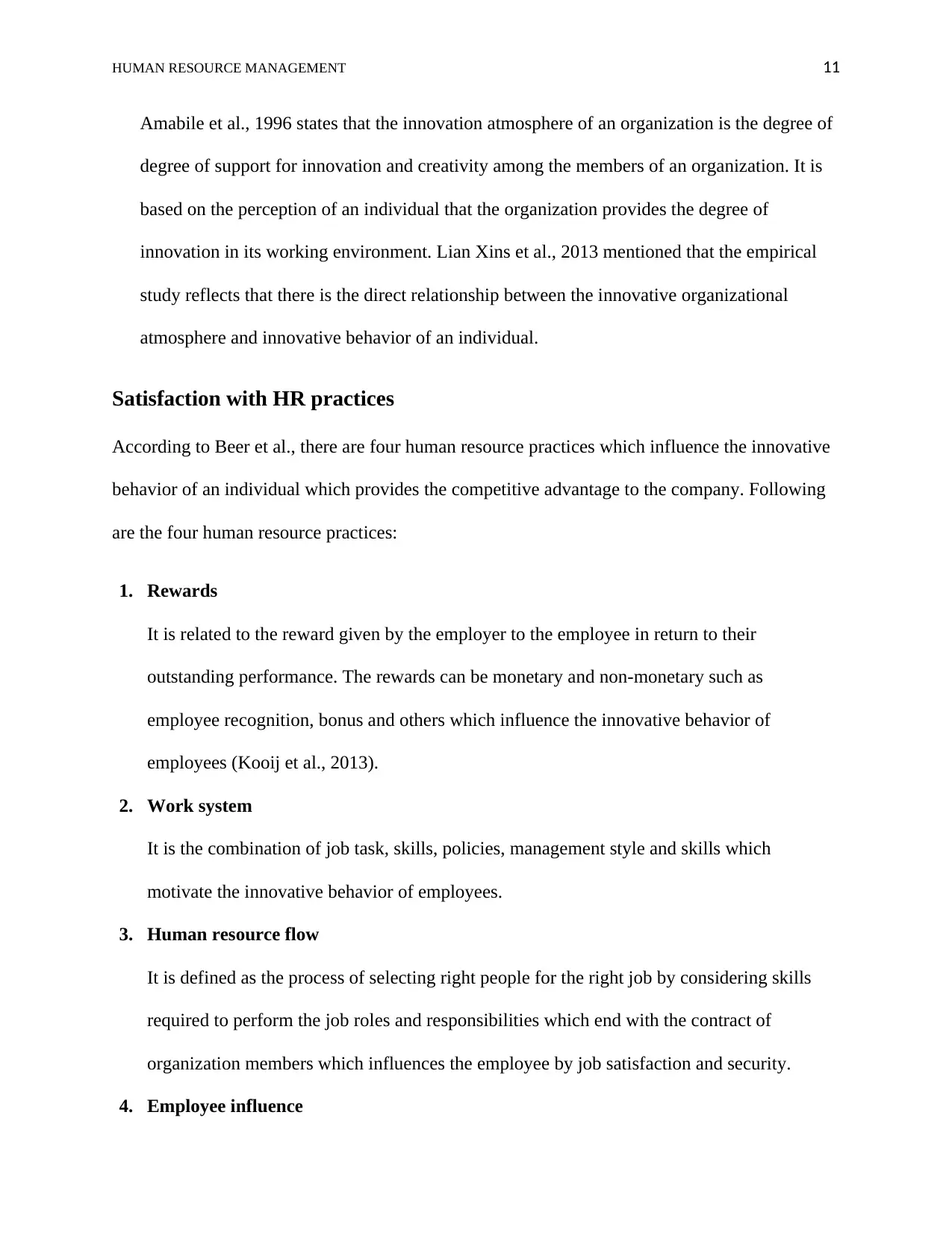
HUMAN RESOURCE MANAGEMENT 11
Amabile et al., 1996 states that the innovation atmosphere of an organization is the degree of
degree of support for innovation and creativity among the members of an organization. It is
based on the perception of an individual that the organization provides the degree of
innovation in its working environment. Lian Xins et al., 2013 mentioned that the empirical
study reflects that there is the direct relationship between the innovative organizational
atmosphere and innovative behavior of an individual.
Satisfaction with HR practices
According to Beer et al., there are four human resource practices which influence the innovative
behavior of an individual which provides the competitive advantage to the company. Following
are the four human resource practices:
1. Rewards
It is related to the reward given by the employer to the employee in return to their
outstanding performance. The rewards can be monetary and non-monetary such as
employee recognition, bonus and others which influence the innovative behavior of
employees (Kooij et al., 2013).
2. Work system
It is the combination of job task, skills, policies, management style and skills which
motivate the innovative behavior of employees.
3. Human resource flow
It is defined as the process of selecting right people for the right job by considering skills
required to perform the job roles and responsibilities which end with the contract of
organization members which influences the employee by job satisfaction and security.
4. Employee influence
Amabile et al., 1996 states that the innovation atmosphere of an organization is the degree of
degree of support for innovation and creativity among the members of an organization. It is
based on the perception of an individual that the organization provides the degree of
innovation in its working environment. Lian Xins et al., 2013 mentioned that the empirical
study reflects that there is the direct relationship between the innovative organizational
atmosphere and innovative behavior of an individual.
Satisfaction with HR practices
According to Beer et al., there are four human resource practices which influence the innovative
behavior of an individual which provides the competitive advantage to the company. Following
are the four human resource practices:
1. Rewards
It is related to the reward given by the employer to the employee in return to their
outstanding performance. The rewards can be monetary and non-monetary such as
employee recognition, bonus and others which influence the innovative behavior of
employees (Kooij et al., 2013).
2. Work system
It is the combination of job task, skills, policies, management style and skills which
motivate the innovative behavior of employees.
3. Human resource flow
It is defined as the process of selecting right people for the right job by considering skills
required to perform the job roles and responsibilities which end with the contract of
organization members which influences the employee by job satisfaction and security.
4. Employee influence
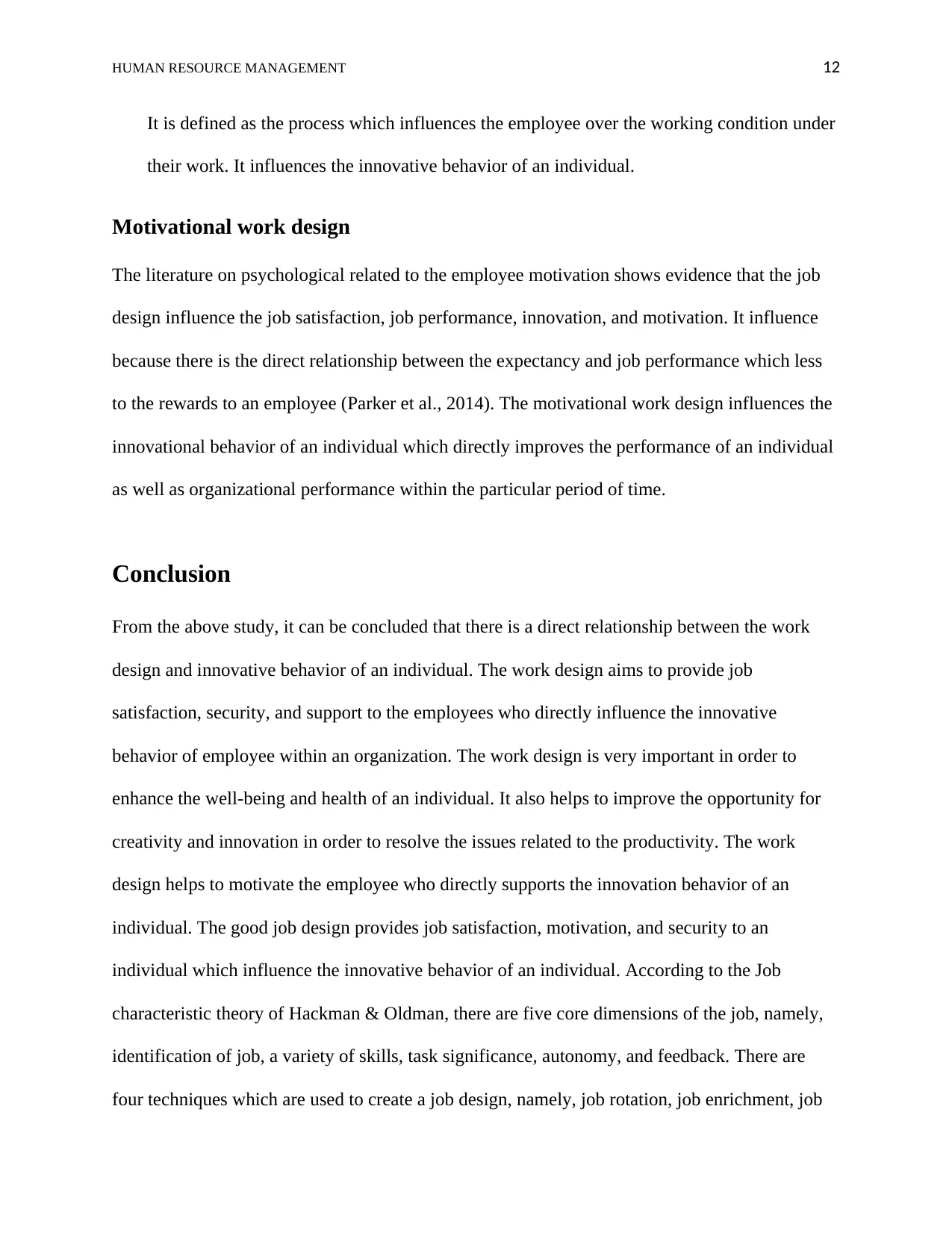
HUMAN RESOURCE MANAGEMENT 12
It is defined as the process which influences the employee over the working condition under
their work. It influences the innovative behavior of an individual.
Motivational work design
The literature on psychological related to the employee motivation shows evidence that the job
design influence the job satisfaction, job performance, innovation, and motivation. It influence
because there is the direct relationship between the expectancy and job performance which less
to the rewards to an employee (Parker et al., 2014). The motivational work design influences the
innovational behavior of an individual which directly improves the performance of an individual
as well as organizational performance within the particular period of time.
Conclusion
From the above study, it can be concluded that there is a direct relationship between the work
design and innovative behavior of an individual. The work design aims to provide job
satisfaction, security, and support to the employees who directly influence the innovative
behavior of employee within an organization. The work design is very important in order to
enhance the well-being and health of an individual. It also helps to improve the opportunity for
creativity and innovation in order to resolve the issues related to the productivity. The work
design helps to motivate the employee who directly supports the innovation behavior of an
individual. The good job design provides job satisfaction, motivation, and security to an
individual which influence the innovative behavior of an individual. According to the Job
characteristic theory of Hackman & Oldman, there are five core dimensions of the job, namely,
identification of job, a variety of skills, task significance, autonomy, and feedback. There are
four techniques which are used to create a job design, namely, job rotation, job enrichment, job
It is defined as the process which influences the employee over the working condition under
their work. It influences the innovative behavior of an individual.
Motivational work design
The literature on psychological related to the employee motivation shows evidence that the job
design influence the job satisfaction, job performance, innovation, and motivation. It influence
because there is the direct relationship between the expectancy and job performance which less
to the rewards to an employee (Parker et al., 2014). The motivational work design influences the
innovational behavior of an individual which directly improves the performance of an individual
as well as organizational performance within the particular period of time.
Conclusion
From the above study, it can be concluded that there is a direct relationship between the work
design and innovative behavior of an individual. The work design aims to provide job
satisfaction, security, and support to the employees who directly influence the innovative
behavior of employee within an organization. The work design is very important in order to
enhance the well-being and health of an individual. It also helps to improve the opportunity for
creativity and innovation in order to resolve the issues related to the productivity. The work
design helps to motivate the employee who directly supports the innovation behavior of an
individual. The good job design provides job satisfaction, motivation, and security to an
individual which influence the innovative behavior of an individual. According to the Job
characteristic theory of Hackman & Oldman, there are five core dimensions of the job, namely,
identification of job, a variety of skills, task significance, autonomy, and feedback. There are
four techniques which are used to create a job design, namely, job rotation, job enrichment, job
⊘ This is a preview!⊘
Do you want full access?
Subscribe today to unlock all pages.

Trusted by 1+ million students worldwide
1 out of 15
Related Documents
Your All-in-One AI-Powered Toolkit for Academic Success.
+13062052269
info@desklib.com
Available 24*7 on WhatsApp / Email
![[object Object]](/_next/static/media/star-bottom.7253800d.svg)
Unlock your academic potential
Copyright © 2020–2025 A2Z Services. All Rights Reserved. Developed and managed by ZUCOL.





